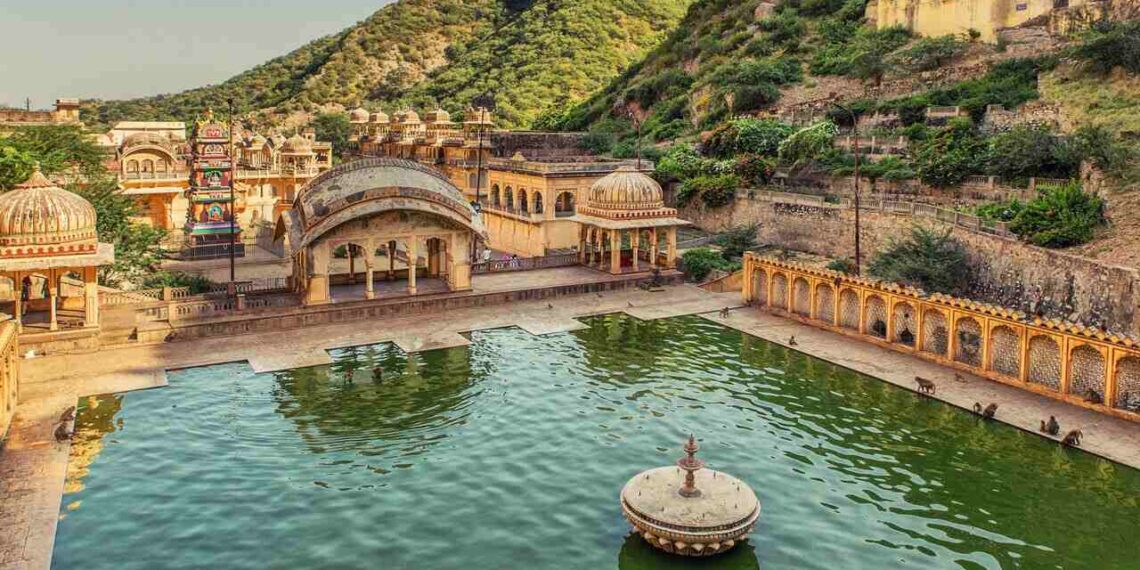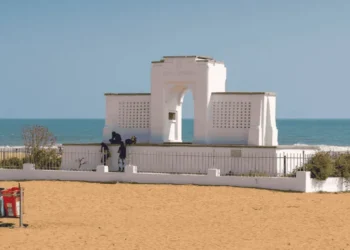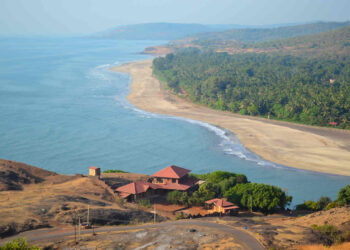The Galtaji Temple, about 10 kilometers east of Jaipur, Rajasthan, is a special shrine mainly dedicated to Lord Hanuman, but it also honors Lord Rama, Lord Krishna, and other gods. Tucked in a narrow valley in the Aravalli hills, this temple complex, known for its holy springs and many monkeys, the complex includes several temples built along the rocky slopes.
A natural spring originates from the top of the hill and flows down into a series of holy water tanks, or kunds, where pilgrims come to bathe. Climbing further past the uppermost kund leads to a temple perched on the hilltop, offering sweeping views of Jaipur and the surrounding forts. The place is closely associated with the sage Galav, who is said to have lived and meditated here, carrying out intense spiritual practices. This blog gives clear information about the temple’s past, how it’s built, why it matters for worship, and what you need to know to visit.
History of Galtaji Temple
The Galtaji Temple was built in the early 1500s by Diwan Rao Kriparam, a close helper of Sawai Jai Singh II, who started Jaipur. A local story says a great sage named Galav prayed here for years, and his faith brought the temple’s holy springs, seen as a gift from the gods. The temple grew as a key place for the Ramanandi sect, which follows Saint Ramanand’s ideas about loving and worshipping Lord Rama. It’s also tied to the Galta Peeth, a big center for Vaishnava worship.
Jaipur’s royal family helped keep the temple going over the years. Today, priests and a local trust take care of it, keeping its sacred and historical value strong. Also known as the “Monkey Temple” because of the many monkeys around, Galtaji pulls in devotees and visitors for its mix of faith and natural beauty.
Shri Galta Peeth
The Galtaji temple is located in a mountain pass within the Aravalli Hills. Since the early 1400s, it has served as a spiritual retreat for Hindu monks of the Ramananda Sampradaya, a Vaishnava tradition founded by Shri Ramanand. Historical accounts suggest that yogis lived at this site for many years before Payohari Krishnadas, a revered Ramanandi saint, arrived in the 15th century and took over as the head of the Galta seat, replacing the earlier yogis.
Galta went on to become the first major Ramanandi center in northern India and played a key role in the spread of the sect. Shri Krishnadas Payahari’s influence grew far and wide, and he initiated Shri Bhagwanji from Punjab into the Ramanandi order. Shri Bhagwanji later established the important Ramanandi site at Pandori Dham in Gurdaspur, Punjab. The temple complex also includes a shrine dedicated to Goswami Nabha Das Ji, another respected saint of the Ramanandi tradition. He is known to have met the poet-saint Tulsidas, the author of the Ramcharitmanas, right here at Galta Dham.
How the Temple Is Built
The Galtaji Temple sits in a rocky valley of the Aravalli hills, made with pink sandstone in a classic Rajasthani style. The complex has seven holy water tanks, called kunds, with the Galta Kund being the most special, said to never dry up. The main temple is dedicated to Lord Hanuman. His large idol is covered in red cloth and thick sindoor, making it stand out the moment you step in. Nearby, there are smaller temples for Lord Rama, Lord Krishna, and Surya, the Sun God. It’s quiet and peaceful, perfect for prayer. If you walk up the hills nearby, you’ll find little shrines and quiet spots to sit and meditate.
Why It Matters for Worship
The Galtaji Temple is a big place for Hanuman worship in Jaipur, especially during Hanuman Jayanti in April and Ram Navami. Hanuman who is also known as Lord Rama’s most loyal devotee, is prayed to for strength, courage, and safety. People believe bathing in the Galta Kund and praying at the temple bring blessings for peace and power. The temple’s tie to the Ramanandi sect makes it a key spot for devotees of Lord Rama. Priests do three daily aartis—morning, noon, and evening—with chants and incense creating a holy atmosphere.
Visiting Information for Galtaji Temple
How to Get There
The temple is in Galtaji, about 10 kilometers east of Jaipur, near Surajpol Bazaar.
By Plane: The nearest airport is Jaipur International Airport, 20 kilometers away. Taxis and buses go from Jaipur to Galtaji, and the temple is a short ride from there.
By Train: Jaipur Railway Station, 12 kilometers away, connects to Delhi, Mumbai, and other cities. From the station, take an auto-rickshaw, taxi, or bus to Galtaji.
By Road: Galtaji is 10 kilometers from Jaipur via NH21. Taxis, buses, or your own car can get to the temple, and there is a parking lot nearby.
Temple Hours
The temple opens at 5:00 AM every day and closes at 9:00 PM. During Hanuman Jayanti and Ram Navami, it stays open longer for more people. Check with temple workers for exact hours during festivals.Best Time to GoThe best time is October to March, when it’s cool, from 10°C to 25°C. Hanuman Jayanti and Ram Navami are busy with festivals but great to see. Summers, from April to June, can be hot, up to 40°C, so go early in the morning. Rainy months, July to September, might make roads harder to travel.
Rules for Visitors
Dress respectfully when visiting the temple. Men are expected to wear shirts with trousers or dhotis, along with a cloth over the shoulder. Women should wear sarees, half-sarees, or churidars with a dupatta. Avoid wearing jeans, sleeveless tops, or shorts.
Shoes must be removed before entering, and there’s a spot to leave them safely for ₹2 per pair. Chewing betel leaves or tobacco, and spitting, are not allowed in the temple area. Photography inside the temple might be restricted, so it’s best to ask before taking pictures.
There’s no entry fee, but donations are welcome and help with the upkeep of the temple.
Final Words
The Galtaji Temple in Jaipur is more than just a place of worship, it’s a peaceful retreat full of history, nature, and devotion. Whether you’re coming to pray, explore, or just enjoy the calm surroundings, Galtaji leaves a lasting impression—making it a must visit in your travel list.











